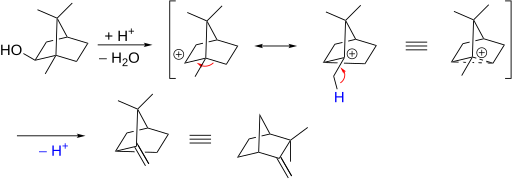Rearrangement reaction
This article uses too much jargon, which needs explaining or simplifying. (January 2024) |
A rearrangement reaction is an organic reaction where the carbon skeleton of a molecule is rearranged. The result is a structural isomer of the original molecule.[1] Often a substituent moves from one atom to another atom in the same molecule. In the example below, the substituent R moves from carbon atom 1 to carbon atom 2:

Intermolecular rearrangements also take place.
Sometimes chemists draw diagrams with arrows that show how electrons are transferred between bonds during a rearrangement reaction. Many organic chemistry text books have such diagrams. But they do not tell the full story of the reaction mechanism. The actual mechanism of a rearrangement with an alkyl group moving is for the group to slide smoothly along a bond, not ionic bond-breaking and forming. One example of this is the Wagner-Meerwein rearrangement:
In pericyclic reactions, the orbital interactions are important. The reactions can not be explained by a series of simple discrete electron transfers. The curved arrows showing a sequence of discrete electron transfers can give the same result as a rearrangement reaction. Yet, the diagrams are not necessarily realistic. In allylic rearrangement, the reaction is ionic.
Three important rearrangement reactions are 1,2-rearrangements, pericyclic reactions and olefin metathesis.
1,2-rearrangements
changeA 1,2-rearrangement is an organic reaction where a substituent moves from one atom to another atom in a chemical compound. In a 1,2 shift, the substituent moves between two adjacent atoms. Moves over larger distances are possible. Examples are the Wagner-Meerwein rearrangement:
and the Beckmann rearrangement:
Pericyclic reactions
changeA pericyclic reaction is a type of reaction with multiple carbon-carbon bond making and breaking. The transition state of the molecule has a cyclic geometry. The reaction progresses in a concerted fashion. Examples are hydride shifts
and the Claisen rearrangement:
Olefin metathesis
changeOlefin metathesis is a formal exchange of the alkylidene fragments in two alkenes. It is a catalytic reaction with carbene. It has transition metal carbene complex intermediates.
References
change- ↑ March, Jerry (1985), Advanced Organic Chemistry: Reactions, Mechanisms, and Structure (3rd ed.), New York: Wiley, ISBN 0-471-85472-7

